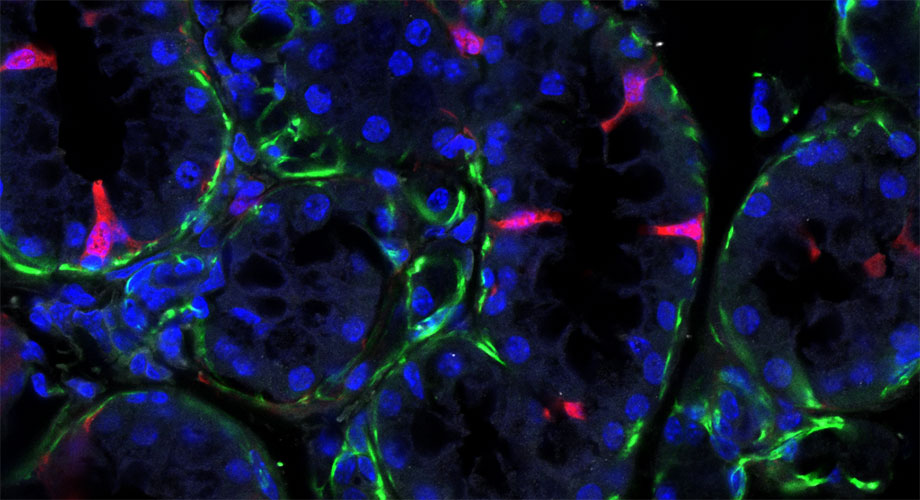
Researchers discover a cell called an ionocyte in salivary glands that is likely crucial for oral health and may have implications for cystic fibrosis. Genetically labeled epithelial FGF10-expressing ionocytes (red) directly contact with contractile myoepithelial cells (green) of the gland, which release saliva from the ducts (nuclei shown in blue). Credit: Scripps Research
Newly identified cell type could be the key to restoring damaged salivary glands
Scripps Research scientists make fundamental advance in understanding salivary gland biology.
April 12, 2022
LA JOLLA, CA—Scientists at Scripps Research and the National Institute of Dental and Craniofacial Research have discovered a special type of cell that resides in salivary glands and is likely crucial for oral health.
As the researchers described in Cell Reports on April 12, 2022, the new type of salivary gland cell called “ionocyte” that works to maintain healthy concentrations of charged molecules—ions—of potassium, calcium, chlorine, and other electrolytes in saliva. The scientists also found that this type of ionocyte secretes a key growth factor (fibroblast growth factor 10, or FGF10), suggesting that it has a further role in the repair of salivary glands after injury.
“These are unique cells, and we hope that by studying them we can develop better treatments for the many medical conditions that affect salivary glands and related glands such as tear glands,” says study co-senior author Helen Makarenkova, PhD, associate professor in the Department of Molecular Medicine at Scripps Research.
Salivary glands produce saliva, which makes it much easier for animals to swallow food. Saliva also contains enzymes that assist in digestion, antibodies and other immune elements to protect against infection, and finely tuned concentrations of different ions to maintain the overall health of teeth and oral tissues. Salivary glands can be damaged by cancer-related radiation therapy in the head and neck region and other medical conditions including autoimmune disorders.
“Each year, millions of Americans are diagnosed with dry mouth conditions, whose precise causes are often unclear,” says study co-first author Olivier Mauduit, PhD, a postdoctoral research associate in the Makarenkova lab.
The team, together with co-senior author Matthew Hoffman, PhD, of the National Institute of Dental and Craniofacial Research, focused first on a growth factor protein called FGF10, which is important for the early development of salivary glands, and is suspected to have a maintenance and repair function in adult salivary glands. The scientists’ aim was to discover the cell type that produces FGF10 in adult salivary glands.
The team analyzed large single cell atlases of mouse gene activity, and isolated FGF10-expressing cells for in-depth gene expression analysis. In this way, they found that while mesenchymal cells called fibroblasts produce FGF10 in very young mice, a very different cell type—a type of salivary duct-lining epithelial cell—takes over production starting in the second week of life.
The researchers showed that this FGF10-producing epithelial cell has molecular markers indicating that it is an ionocyte, an evolutionarily ancient cell type that maintains proper levels of ions and related molecules in local tissues.
Among the products of this ionocyte, they observed, is the cystic fibrosis transmembrane conductance regulator protein (CFTR). This protein is best known as the cause of the lung disease cystic fibrosis when it is absent in lungs through inherited mutation. However, it is also known to have an important role in salivary and tear glands, where its deficiency contributes to a common, inflammatory, dry-mouth/eye syndrome called Sjögren’s syndrome. The identification of the cell type that produces CFTR in the adult salivary gland might thus lead to better therapies for this syndrome, the researchers said.
The researchers noted too that this newly identified ionocyte’s FGF10-producing function makes it unique among ionocytes.
“The fact that this cell is the producer of FGF10 in adult salivary glands suggests that it could have a big role in gland maintenance and repair after injury,” says study co-author Vanessa Delcroix, PhD, a postdoctoral researcher in the Makarenkova laboratory.
Although their initial analyses concerned mouse cells, the researchers found evidence of very similar salivary gland ionocytes in a protein atlas of human tissues.
The researchers now are following up with further studies, including in human cells. Their hope is that a better understanding of how these FGF10-making ionocytes work in the adult salivary gland will pave the way for effective therapies for conditions affecting salivary glands as well as tear glands, given the many similarities between the two.
“A mesenchymal to epithelial switch in FGF10 expression specifies an evolutionary conserved population of ionocytes in salivary gland” was co-first authored by Olivier Mauduit of Scripps Research and by Marit Aure of the National Institute of Dental and Craniofacial Research. The other authors were Vanessa Delcroix, Liana Basova, Amrita Srivastava, Takeshi Umazume and Helen Makarenkova, of Scripps Research; Jacqueline Mays and Matthew Hoffman of the National Institute of Dental and Craniofacial Research; Saverio Bellusci of Justus-Liebig University Giessen; Abigail Tucker of King’s College London; and Mohammad Hajihosseini of the University of East Anglia.
Support for the research included grants from the National Eye Institute (5R01EY026202, 5R01EY028983) and the National Institute of Dental and Craniofacial Research (R01DE031044).
For more information, contact press@scripps.edu

